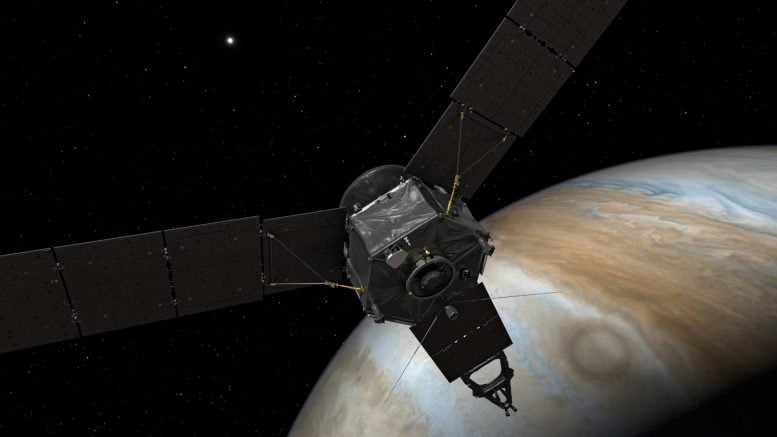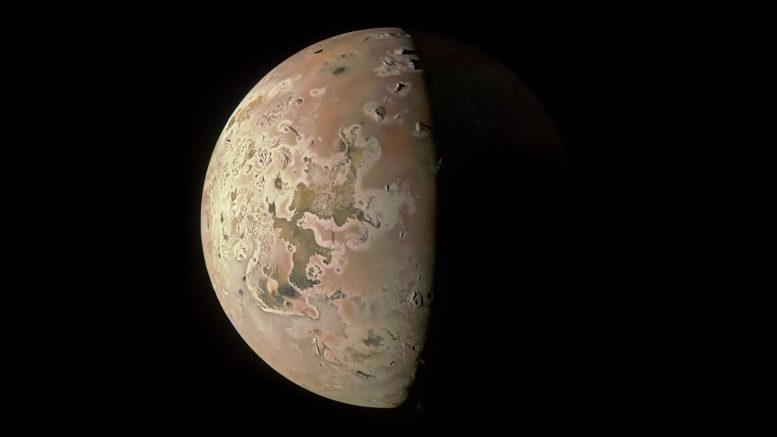On February 3, NASA’s Juno spacecraft captured images of two volcanic plumes on Jupiter’s moon Io, possibly indicating activity from either two vents of a single volcano or two separate volcanoes. The Juno team plans to analyze this event in conjunction with data from previous missions to enhance our understanding of Io’s volcanic dynamics. Credit: NASA/JPL-Caltech/SwRI/MSSS, AndreaLuck © CC BY
NASA’s Juno spacecraft observed two volcanic plumes on Io, suggesting significant volcanic activity on Jupiter’s moon.
In a significant astronomical achievement, NASA’s Juno spacecraft has once again broadened our understanding of the solar system’s dynamics by capturing two volcanic plumes rising above the horizon of Jupiter’s moon Io.
This event, recorded on February 3, presents a fascinating glimpse into the volcanic activity that characterizes Io, one of the most geologically active bodies in our solar system. The images, captured by Juno’s JunoCam instrument from a distance of approximately 2,400 miles (3,800 kilometers), showcase plumes that could have originated from two vents belonging to a single massive volcano or from two distinct volcanoes located in proximity to each other.
This discovery opens new avenues for analysis, as the Juno team plans to compare these observations with other data gathered by Juno and previous missions to deepen our understanding of Io’s volcanic nature.

An illustration shows NASA’s Juno spacecraft as it entered orbit of Jupiter on July 4, 2016, after traveling for nearly five years and more than 1.7 billion miles. Credit: NASA/JPL/SwRI
Background on Juno’s Mission
Launched on August 5, 2011, the Juno spacecraft embarked on a mission to explore Jupiter, the largest planet in our solar system. Juno’s objectives are multifaceted, aiming to unveil the secrets of Jupiter’s atmosphere, magnetic environment, and structure.
By studying Jupiter, scientists hope to gain insights into the formation of the solar system, understanding how gas giants form and the role these massive planets play in constructing planetary systems.
After a journey of nearly five years, Juno entered Jupiter’s orbit on July 4, 2016, and has since been conducting close-up observations of the planet and its moons. Juno’s suite of scientific instruments, including the JunoCam, a color, visible-light camera, has provided unprecedented views of Jupiter’s atmosphere and detailed images of its moons, including Io.

This image revealing the north polar region of the Jovian moon Io was taken on October 15, 2023, by NASA’s Juno. Three of the mountain peaks visible in the upper part of image, near the day-night dividing line, were observed here for the first time by the spacecraft’s JunoCam. Credit: Image data: NASA/JPL-Caltech/SwRI/MSSS, Image processing by Ted Stryk
Io: A Volcanic Powerhouse
Io stands out as the most volcanically active moon in the solar system, a distinction that has fascinated scientists since its volcanic nature was first revealed by the Voyager spacecraft in 1979.
This innermost moon of Jupiter is slightly larger than Earth’s moon and is subject to intense gravitational interactions with Jupiter and its other large moons. These interactions generate tidal heating, which is responsible for Io’s geological activity, including its hundreds of volcanoes, some of which eject plumes of sulfur and sulfur dioxide gas and dust high into space.
The volcanic activity on Io continuously reshapes its surface, making it a primary subject of study for understanding extraterrestrial volcanism.
The Significance of Juno’s Discovery
The observation of volcanic plumes on Io by Juno’s JunoCam adds a vital piece of evidence to our understanding of Io’s volcanic dynamics. These plumes can rise hundreds of kilometers above Io’s surface, offering a spectacular display of nature’s power beyond Earth. The analysis of these plumes, in conjunction with other data collected by Juno and previous missions, has the potential to reveal new insights into the mechanisms driving Io’s volcanism, the composition of its interior, and how its activity influences the Jovian system. This discovery underscores the importance of continuous exploration and study of our solar system’s celestial bodies, as each finding brings us closer to unraveling the mysteries of the cosmos.
As the Juno mission continues to explore Jupiter and its moons, its findings, such as the volcanic plumes on Io, not only enhance our understanding of the universe but also inspire future missions to further investigate these distant worlds. Through the lens of Juno, we gain a more comprehensive view of the solar system, reminding us of the dynamic and ever-changing nature of space.





